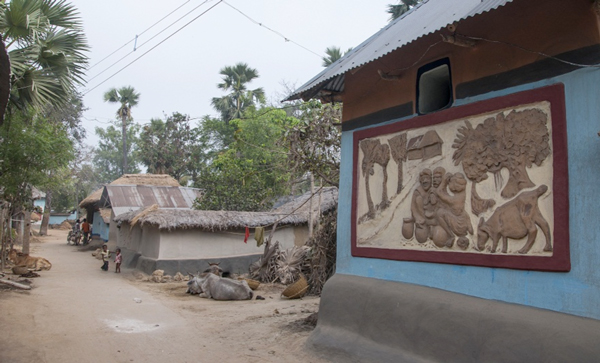
Six Murals by Sanyasi Lohar and his team
- Murals “Santals Celebrate the Seasons” (PDF, 550 KB)
- View or have this eBook read aloud on Archive.org >>
Text and photos by Boro Baski © 2014
Edited by Martin Kämpchen
Published by Ashadullapur Gramin Silpa & Sastha Bidhan Kendra (Ashadullapur) and Ghosaldanga Bishnubati Adibasi Trust (Bishnubati and Kolkata)
Preface
The Santal village Bishnubati is situated about 8 km from Santiniketan and Sriniketan, the abodes which Rabindranath Tagore made famous. Since almost 30 years Bishnubati and its neighbouring Santal village Ghosaldanga have made a singularly vigorous effort to develop their potential in the fields of agriculture, economic uplift, and especially of education and culture. Bishnubati houses a unique Museum of Santal Culture. Sanyasi Lohar, resident of Bishnubati, has been part of the village development programmes from the beginning as a student and then as a teacher. He studied at Kala-Bhavan, the Art Academy of Visva-Bharati (University) at Santiniketan, and returned to Bishnubati to conduct crafts courses (pottery, terracotta and batik) and teach Art at our Santal non-formal school, the Rolf Schoembs Vidyashram.
As an extension of the Santal Museum Sanyasi Lohar has started a unique project. On the outside walls of the mud huts in Bishnubati he has created murals on the life and the seasonal celebrations of the Santals. With his team Sanyasi Lohar has so far completed six large murals which were inaugurated on 27 March 2014 with the participation of the entire village, of many people of neighbouring villages and guests from Santiniketan. Kanta Konra, Sunil Konra, Amit Konra, Budi Baski, Sukol Murmu, Gupin Kishku laboured for several months with their instructors Sanyasi Lohar and Jayanta Sharma to complete these striking and vibrant representations of Santal life.
In this booklet we have followed the seasons from the Flower Festival or Spring Festival celebrated around March until the Sohrai or Harvest Festival celebrated in early January. Marriages normally take place in the summer, so we have placed the mural of the Marriage Reception to follow spring.
We express our gratitude to the Tribal Cultural Heritage in India Foundation (Netherlands) for funding this publication as part of our endeavour to preserve and further evolve Santal culture. We are also thankful to Samiran Nandy (Santiniketan) for expertly taking the pictures of the murals and of the two photographs showing the murals in their village context.
This booklet is an invitation to all readers to come and visit Bishnubati, walk into the Santal Museum and go around the village to view the murals in their living context. We welcome you all!
Dr. Boro Baski
President, Bishnubati Adibasi Marshal Sangha *
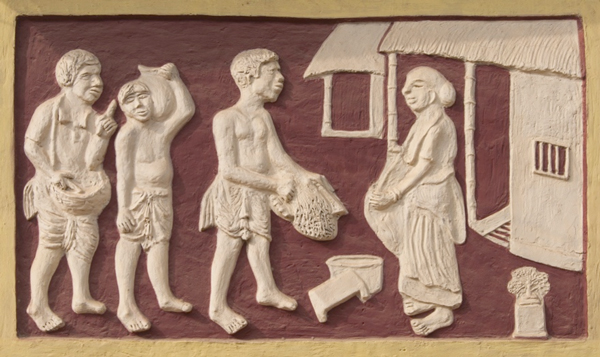
Baha
The Baha Parab is the Flower Festival of the Santals, celebrated in the beginning of spring. The ritual observed revolves around man’s communion with nature and the celebration of beauty. The Naike (Santal priest) and other villagers offer a Sal flower to every family of the village. A Santal woman receives flowers in the folds of her sari from the priest after she has ceremonially applied oil on his feet and then washed them. An unmarried man carries the water on his shoulder and, after exchanging greetings with her, sprinkles it on the woman. During the festival the women stick some flowers into their hair and the men behind their ears. The rest of the flowers are kept in the ceiling of their thatched or tiled roof.
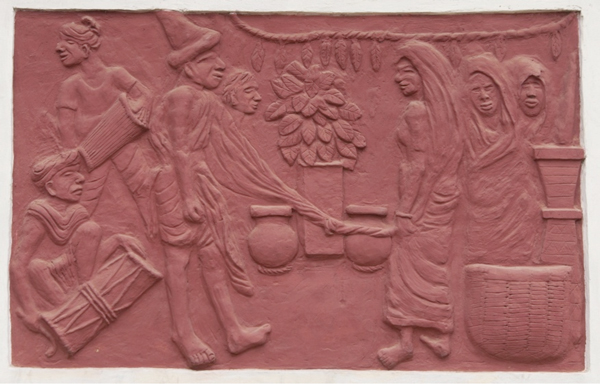
Marriage Reception
A Santal marriage takes five days and involves various, often complex, rituals. On the day of the Gidi-chumara (Marriage Reception) the women arrive to bless the bride and groom with grass and grains of rice which are kept in a basket. The high wooden turmeric crusher called akhur (on the right) indicates that tumeric powder is used to soak the wedding dress in turmeric water to clean it and purify it ritually. The clothes of bride and groom are being tied together as a sign of their oneness. The centre of the courtyard where some of the marriage rituals take place is called Mandwa. There, a branch of the Mahua, the blackberry, the mango or the Sal tree is planted. It is believed that benevolent spirits dwell in these trees. Two earthen pots are placed on either side of the branch. These pots are filled with water and carried along by two unmarried girls of the village. They are meant to remind the bride of her friendship with the village people. A man is playing the marriage drum, behind him is a man with an ordinary drum.
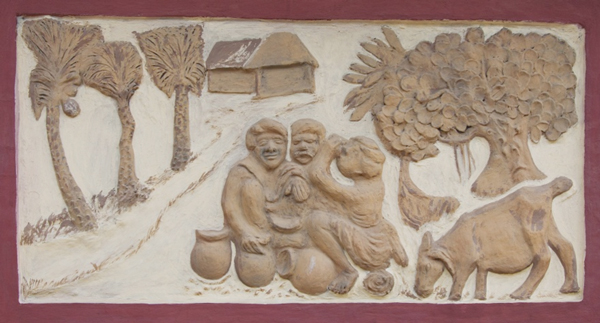
Enjoying Palm Juice
At the end of a village three Santal men sit under a Banyan tree and are happily drinking fermented juice of the tal, a commonly seen palm tree. In the summer, the men climb on the trees to collect the refreshing juice from the tree’s buds in earthen pots. A goat is licking the discarded leaf plate from which the men eat chakhna (snacks) while drinking palm juice.

Dasai
The Dasai Parab, celebrated in October, goes back to a period in history when the Santals had to defend themselves and hide their identity behind masks.
During the festival not much of this martial spirit is left. The men dance with peacock feathers adorning their turbans. Some even dress up as women or wear sack cloth.
The masks are made of earthen pots or hollowed-out pumpkins. This displays some of the humour in Santal celebrations. Later, the women offer handfuls of grain to the dancers as a mark of appreciation and join in the dance.

Sohrai – The First Day
The most important festival of the Santals is called Sohrai. It is the Harvest Festival celebrated after the rice harvest in early January. The celebrations stretch over several days. The first day is Um hiloah. Every family contributes half a kilo of rice, a young chicken, salt, turmeric powder, potatoes, firewood to prepare khichuri, a mixture of rice with dal and potatoes. They also contribute ranu, a fermenting agent like yeast to prepare rice beer. On this first day the men perform a ritual on a field outside the village to initiate the festival. After the ritual performed by the Naike (the priest of the village) the men folk eat khichuri and drink rice beer together. Goget, the messenger later distributes the rest of the khichuri to every family on leaves of the Banyan tree. In the afternoon when the cows return home, an egg is laid on the path to the village. The owner of the cow or buffalo which stamps on the egg will gift a pot of rice beer in the forthcoming Magh Festival of the village.
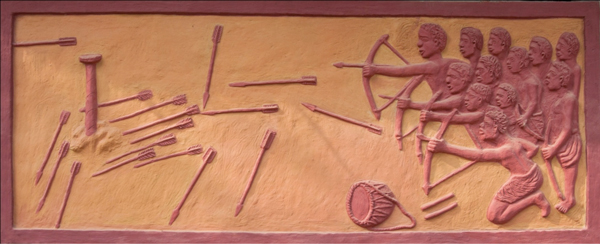
Sakrat – The Last Day of Sohrai
On the last day of the Sohrai Festival a shooting competition takes place. Outside the village the men place a chapati, prepared by the Jog Manjhi haram’s wife, on a short pole made of a banana or aradom stump. The man who can hit the chappati is carried to the village on the shoulders of the other men. They perform gymnastics and acrobatics on the way. Finally, they all assemble at the Manjhi Than, a raised platform in the middle of the village used for performing Puja.
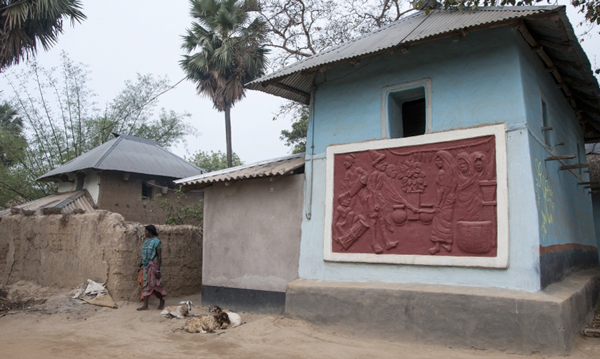
Learn more about the projects initiated by the Ashadullapur Gramin Silpa & Sastha Bidhan Kendra and its founder Sanyasi Lohar >>
Contact
To obtain copies of Santals Celebrate the Seasons, please contact Boro Baski: [email protected]
Contributions are voluntary and contribute to the cultural and educational work of the Ghosaldanga Bishnubati Adibasi Trust (GBAT), a tribal NGO registered under the Indian Trust Registration Act, 1982.
Ghosaldanga Bishnubati Adibasi Trust Ashadullapur (Bishnubati)
Village Bishnubati /Ashadullapur
P.O. Sattore
Dist. Birbhum 731236
West Bengal
India
Sanyasi Lohar: +91 9434636856 [email protected]
All contents are being published with an understanding that the respective copyright owners have agreed to the license terms explained in the Creative Commons Attribution-NonCommercial-NoDerivs 3.0 Unported License. This means that no commercial use or modification of such content is permissible without written consent by their respective copyright holders.
Santal culture: music, video, eBooks and more
Audio | Santali Traditional and Fusion Songs: Ghosaldanga Bishnubati Adibasi Trust – West Bengal
eBook | Background guide for education
eBook | Free catalogue: Banam: One of the ancient musical instruments of the Santals – West Bengal
eBook | Free catalogue: Museum of Santal Culture (Bishnubati) – West Bengal
Education and literacy | Right to education
Infusing the Santhali Element in Schooling by Rina Mukherji
RSV School & Museum of Santal Culture
Santal | Santal Parganas | The Santals by Boro Baski | Santal music
Santals as a community: A brief introduction to their culture and approach to development
Video | Roots and Branches: The Lifeworld of an Enlightened Villager in West Bengal
Video | Santali video album “Ale Ato” (Our Village, Part 1 of 2) – West Bengal
To locate the Museum of Santal Culture in Bishnubati village (near Santiniketan) on the map seen below, open by clicking on the left button:
Tips for using interactive maps
Toggle to normal view (from reader view) should the interactive map not be displayed by your tablet, smartphone or pc browser
For details and hyperlinks click on the rectangular button (left on the map’s header)
Scroll and click on one of the markers for information of special interest
Explore India’s tribal cultural heritage with the help of another interactive map >>
